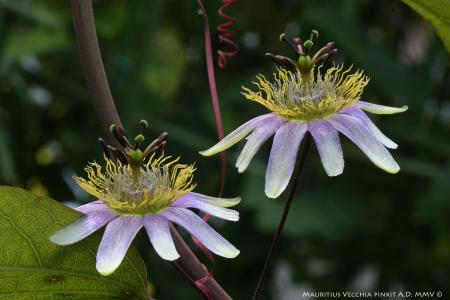
SUBGENUS: decaloba
SUPERSECTION: decaloba
SECTION: decaloba
GEOGRAPHICAL DISTRIBUTION OR ORIGIN:
Salvador and Costa Rica.
MINIMUM TEMPERATURE: 10 °C
IDEAL MINIMUM TEMPERATURE: 12 °C
SYNONYMS: P. macrostemma Killip
ETYMOLOGY: Dedicated to Paul Standley (1884 - 1963), botanist and researcher, author of numerous publications dedicated to the flora of South America.
NOTES: Chromosomes: 2n=12.
DESCRIPTION:
There are very few passionflowers that possess leaves with two lobes longer than those of P. standleyi, calling to mind the ears of a rabbit. They are bilobate, typical of the subgenus Decaloba. In this case, the characteristic is accentuated.
A peculiarity that makes this plant very pleasing. The lobes are parallel or slightly open and occupy at least half of the total length of the leaf, which reaches about 12-13 cm. The width, in contrast, is only 4-5 cm, giving the leaf a narrow, elongated shape. The colour is equally singular: the upper surface is dark green with violet or reddish tinges that are more evident on the veins and leaf glands scattered in parallel rows on the leaf. The reverse is coloured dark purple.
The red-violet colour, of varying shades, dominates the whole aerial part. The stems have the same characteristic, which even pervades the petals and sepals.
Despite their small size, just 3-4 cm in diameter, the flowers, thanks to their continued abundance, decisively decorate and embellish the ends of all growing shoots. The petals and sepals are a delicate light violet, fading to pinkish-white towards the apex. They are usually retroflexed, so as to accentuate the contrast with the yellow-green corona. The filaments, as thin as a hair, are arranged in two dense series, the outer ones being of a bright, decisive yellow. They are so light that the corona resembles a down jacket.
The fruits are small black spheres with a diameter of about 12 mm.
This plant, native to the mountains of San Salvador and Costa Rica, is easy to cultivate, as it is vigorous and remarkably resilient.
In winter, it can withstand temperatures down to 5-6°C; however, a few degrees higher will offer a greater margin of safety. A good multipurpose soil enriched with pumice should be used so as to allow adequate root development. Over-frequent and abundant watering should be avoided in order to circumvent the risk of root asphyxiation.
It propagates from cuttings or from seed.